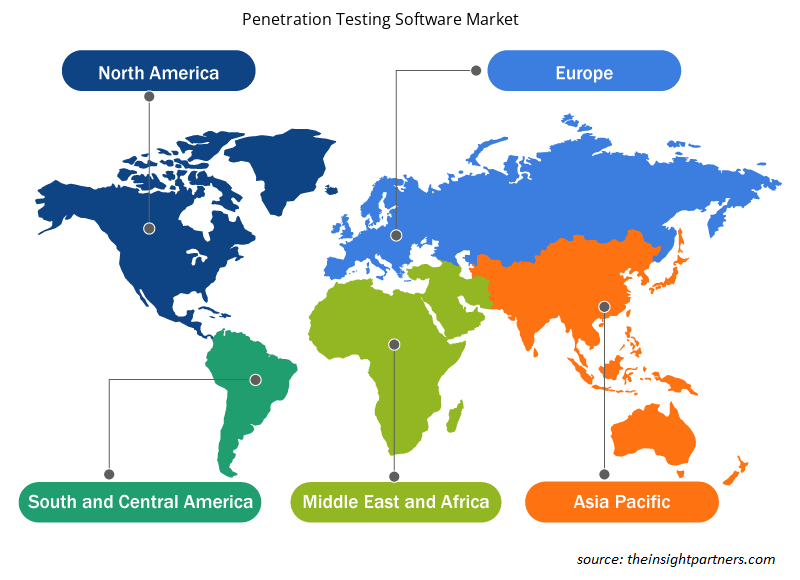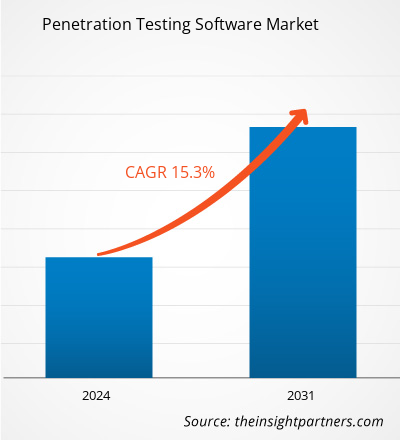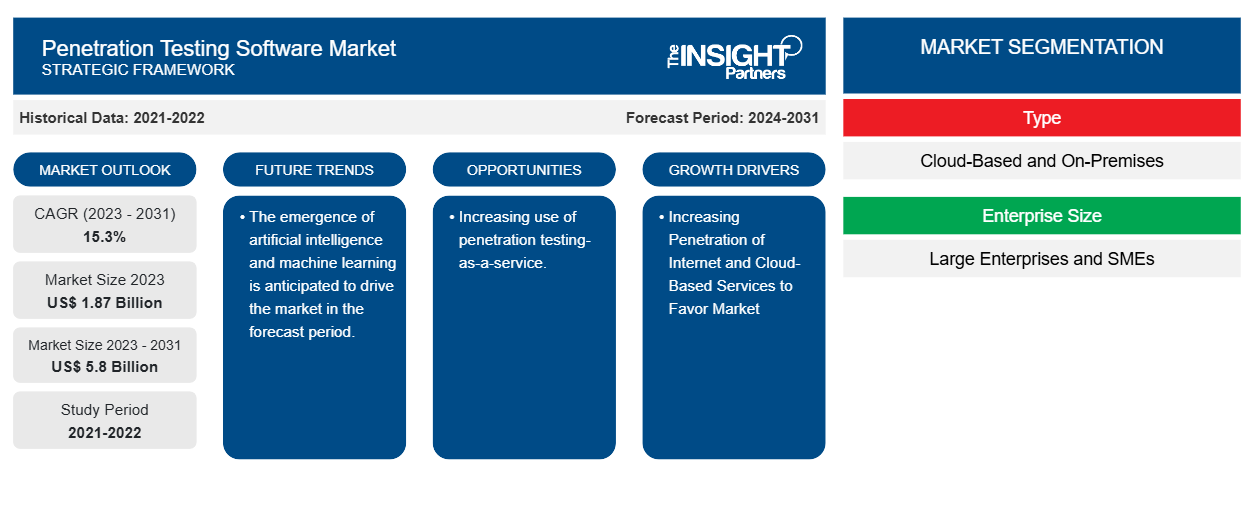渗透测试软件市场规模预计将从 2023 年的 18.7 亿美元增至 2031 年的 58.5 亿美元。预计该市场在 2023-2031 年期间的复合年增长率将达到 15.3%。互联网和基于云的服务渗透率的提高以及越来越严格的规则和合规要求使得渗透测试软件的使用成为必需,这些可能是渗透测试软件市场的主要趋势和驱动因素。
渗透测试软件市场分析
全球范围内,渗透测试软件市场正在经历显著增长。这种增长归因于互联网和云服务渗透率的提高,以及越来越严格的规则和合规要求,这些都要求必须使用渗透测试软件。此外,渗透测试即服务和远程工作安全的日益增长的趋势以及人工智能和机器学习支持的部署模型的出现预计将在未来几年为市场带来许多机会。
渗透测试软件市场概况
渗透测试 (或笔测试) 是一种安全演习,其中网络安全专家试图查找和利用计算机系统中的漏洞。这种模拟攻击的目的是识别攻击者可以利用的系统防御弱点。
定制此报告以满足您的需求
您可以免费定制任何报告,包括本报告的部分内容、国家级分析、Excel 数据包,以及为初创企业和大学提供优惠和折扣
-
获取此报告的关键市场趋势。这个免费样品将包括数据分析,从市场趋势到估计和预测。
渗透测试软件市场驱动因素和机遇
互联网和云计算服务的渗透率不断提高,利好市场。
互联网提供的服务几乎无穷无尽:它使全球通信和协作成为可能、进行国际汇款(包括汇款)、学习和教育他人、建立跨境社交联系、分享新闻等等。2023 年,全球 63% 的人口上网,因为互联网普及率增加了漏洞和网络钓鱼攻击的可能性。网络渗透测试的目标是揭示和识别组织内的任何漏洞。这包括通过外部测试和内部测试(例如 Web 应用程序测试和模拟网络钓鱼攻击)对网络安全措施进行深入评估。因此,考虑到上述参数,互联网和基于云的服务的不断增加的参数正在推动市场的发展。
越来越多地使用渗透测试即服务。
PTaaS 是一种渗透测试方法,它将手动和人工测试整合到云交付平台上,使 IT 专业人员能够完成即时和持续渗透测试。PaaS 的使用正在增加,因为它允许组织识别和解决漏洞,而无需大量人力。此外,许多其他公司也参与了 PaaS 的推出,从而推动了市场的发展。例如,2024 年 3 月,Bishop Fox 宣布了其 Cosmos 应用程序渗透测试 (CAPT) 服务,该服务将渗透测试与按需评估和分析服务相结合。因此,考虑到上述参数,预计渗透测试即服务的使用将在未来几年推动市场发展。
渗透测试软件市场报告细分分析
有助于渗透测试软件市场分析的关键部分是类型、企业规模和应用。
- 根据类型,渗透测试软件市场分为基于云和本地两种。预计基于云的部分将在预测期内占据相当大的市场份额。
- 根据企业规模,渗透测试软件市场分为大型企业和中小型企业。预计大型企业在预测期内将占据相当大的市场份额。
- 根据应用,市场分为 Web 应用、网络基础设施、移动应用、社交工程等。预计 Web 应用将在预测期内占据相当大的市场份额。
渗透测试软件市场份额按地区分析
渗透测试软件市场报告的地理范围主要分为五个地区:北美、亚太、欧洲、中东和非洲、南美和中美。
北美主导着渗透测试软件市场。北美市场分为美国、加拿大和墨西哥。市场正在经历显着增长。这种增长归因于互联网和基于云的服务的普及率上升,以及该地区日益严格的规则和合规要求,使得使用渗透测试软件成为必然。此外,美国和加拿大等发达经济体高度重视研发,这迫使北美参与者将技术先进的解决方案引入市场。此外,美国拥有大量渗透测试软件市场参与者,他们越来越专注于开发创新解决方案。所有这些因素都促进了该地区渗透测试软件市场的增长。
渗透测试软件市场区域洞察
Insight Partners 的分析师已详细解释了预测期内影响渗透测试软件市场的区域趋势和因素。本节还讨论了北美、欧洲、亚太地区、中东和非洲以及南美和中美洲的渗透测试软件市场细分和地理位置。

- 获取渗透测试软件市场的区域特定数据
渗透测试软件市场报告范围
| 报告属性 | 细节 |
|---|---|
| 2023 年的市场规模 | 18.7亿美元 |
| 2031 年市场规模 | 58亿美元 |
| 全球复合年增长率(2023 - 2031) | 15.3% |
| 史料 | 2021-2022 |
| 预测期 | 2024-2031 |
| 涵盖的领域 |
按类型
|
| 覆盖地区和国家 |
北美
|
| 市场领导者和主要公司简介 |
|
市场参与者密度:了解其对商业动态的影响
渗透测试软件市场正在快速增长,这得益于最终用户需求的不断增长,而这些需求又源于消费者偏好的不断变化、技术进步以及对产品优势的认识不断提高等因素。随着需求的增加,企业正在扩大其产品范围,进行创新以满足消费者的需求,并利用新兴趋势,从而进一步推动市场增长。
市场参与者密度是指在特定市场或行业内运营的企业或公司的分布情况。它表明相对于给定市场空间的规模或总市场价值,有多少竞争对手(市场参与者)存在于该市场空间中。
渗透测试软件市场的主要公司有:
- Veracode 公司
- Rapid7
- 捍卫
- 安库奈特
- 虫群
- 黑客一号
免责声明:上面列出的公司没有按照任何特定顺序排列。

- 获取渗透测试软件市场顶级关键参与者概述
渗透测试软件市场新闻和最新发展
渗透测试软件市场通过收集一手和二手研究后的定性和定量数据进行评估,其中包括重要的公司出版物、协会数据和数据库。渗透测试软件市场的一些发展如下:
- Pentera 宣布 Pentera Cloud 正式上市,作为其自动安全验证平台的一部分,以补充其著名的 Pentera Core 和 Surface 产品。(来源:Pentera 公司网站,2024 年 3 月)
- 三菱电机公司宣布,已开发出全球首款渗透测试2支持工具CATSploit,该工具可根据渗透测试人员的测试目标(例如窃取机密信息)自动生成攻击场景,以评估测试攻击的有效性。(来源:三菱电机公司网站,2023年12月)
渗透测试软件市场报告覆盖范围和交付成果
“渗透测试软件市场规模和预测(2021-2031)”报告对市场进行了详细分析,涵盖以下领域:
- 范围内涵盖的所有主要细分市场的全球、区域和国家层面的渗透测试软件市场规模和预测。
- 渗透测试软件市场趋势以及市场动态,如驱动因素、限制因素和关键机会。
- 详细的 PEST/波特五力分析和 SWOT 分析。
- 渗透测试软件市场分析涵盖主要市场趋势、全球和区域框架、主要参与者、法规和最新的市场发展。
- 行业格局和竞争分析涵盖市场集中度、热图分析、知名参与者以及渗透测试软件市场的最新发展。
- 详细的公司简介。
- 历史分析(2 年)、基准年、预测(7 年)及复合年增长率
- PEST和SWOT分析
- 市场规模、价值/数量 - 全球、区域、国家
- 行业和竞争格局
- Excel 数据集
近期报告
相关报告
客户评价
购买理由
- 明智的决策
- 了解市场动态
- 竞争分析
- 客户洞察
- 市场预测
- 风险规避
- 战略规划
- 投资论证
- 识别新兴市场
- 优化营销策略
- 提升运营效率
- 顺应监管趋势























 获取免费样品 - 渗透测试软件市场
获取免费样品 - 渗透测试软件市场